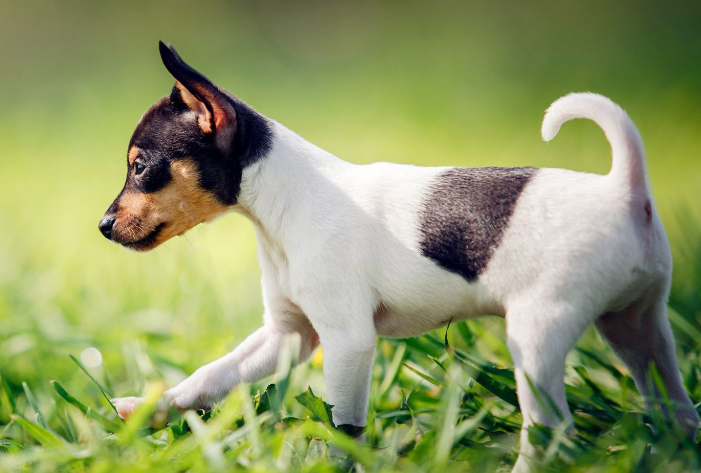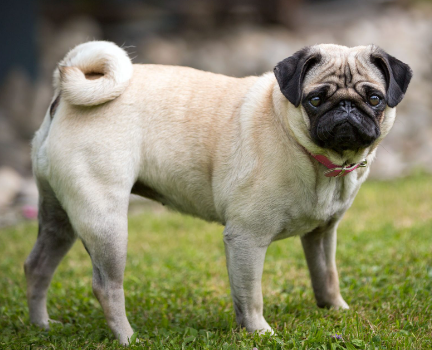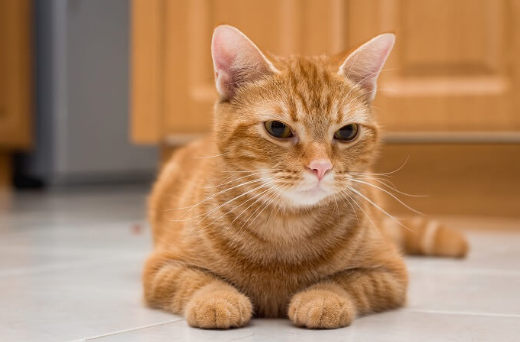The Nebelung, an uncommon breed that originated in the United States during the 1980s, draws its name from the German term “Nebel,” signifying mist or fog.
These captivating felines boast a medium-length fur coat tinted in blue-gray with a silver luster and showcase large green eyes. While they are sometimes likened to the long-haired Russian Blue, these two breeds, though related and sharing similarities in appearance, are not identical.
Nebelung cats may exhibit shyness in unfamiliar environments or with new acquaintances, expressing a preference for a tranquil home environment with minimal commotion. Nevertheless, once they establish a connection with their human companions, they prove to be warm, intelligent, and affectionate pets, forming strong bonds with one or two members of the family.
- Origin: United States
- Height: 9–13 inches
- Weight: 7–15 pounds
- Lifespan: 11–18 years
- Colors: Solid grey-blue
Nebelung Cat Breed Characteristics
Nebelung cats exhibit distinctive features, including a lengthy and graceful neck, long legs, and a tail of considerable length. Their eyes, slightly oval in shape, present a striking green hue, occasionally leaning towards yellow-green.
Atop a modified wedge-shaped head, large, pointed ears contribute to the cat’s distinctive appearance, emphasizing a more pointed than rounded facial structure. The overall impression is one of height, strength, and well-defined musculature. The Nebelung’s soft double coat, fine and silky to the touch, is predominantly gray with silver-tipped accents.
Both males and, to a lesser extent, females may have rugged throats, with tail fur surpassing that of the body in length. Tufts of fur adorn the areas behind the ears and between the toes, while hind legs boast pantaloons.
The Nebelung’s mature coat reaches its full development around the age of two. With a lifespan of over 16 years, these felines typically weigh between 3.5 kg (7.11 lbs) for females and 6.5 kg (14.5 lbs) for neutered males.
| Playfulness: 4 | Grooming Effort: 3 |
| Intelligence: 4 | Pet-Friendly: 3 |
| Energy Level: 3 | Shedding: 3 |
| Health Issues: 2 | Kid-Friendly: 2 |
| Affection Level: 4 | Chattiness: 2 |

History
The Nebelung breed has a relatively recent origin, with its roots traced back to the early 1980s in the United States. The inaugural member, Siegfried, made his debut in 1984 as a male kitten. His parentage included Elsa, a black domestic shorthair under the care of Cora Cobb, and a long-haired cat reminiscent of a Russian Blue. Siegfried emerged as the sole long-haired blue kitten from the litter.
In 1985, Elsa birthed another litter, giving rise to a second long-haired blue kitten named Cora Cobb Brunnhilde. Cobb, captivated by the distinct silvery blue hue reminiscent of the Russian Blue and the domestic silky medium-length coat of these two kittens, envisioned a breeding program to establish Nebelungs as a distinct breed, differentiating them from Russian longhair cats.
The breeding efforts continued, and in 1986, Siegfried and Brünnhilde produced a litter, marking the official inception of the Nebelung breed. Cobb, committed to securing recognition for Nebelungs, sought new breed status from the International Cat Association (TICA) in 1987, with the assistance of geneticist Solveig Pfluger. The breeding program, spanning a decade, established a stringent breed standard based on the long-haired blue cat type introduced to Europe from Russia in the early 19th century.
TICA officially granted recognition to the Nebelung breed in 1997, a milestone echoed by other major world cat registries, including the World Cat Federation and the American Cat Fanciers Association.
Even today, Nebelungs remain exceptionally rare, posing a challenge for enthusiasts to acquire one. Nevertheless, those fortunate enough to welcome a Nebelung into their homes quickly discover the unique qualities that make these cats a prized rarity.
Appearance
The Nebelung presents as a medium-sized feline endowed with a lithe, lengthy, and well-muscled physique. Cloaked in a medium-length, dense coat, the cat’s blue-gray hue is typically adorned with silver-tipped accents.
Accentuating their overall elegant charm, Nebelungs sport lengthy, plume-like tails that harmonize with their extended bodies. The feline’s body maintains a uniform color, devoid of white or other hues, although the fur behind the ears may exhibit a lighter blue shade compared to the rest of the coat. Notably, male Nebelungs may boast a thick mane of fur around their necks.
Distinctive features include the cat’s proportionately large ears, contributing to an alert and attentive appearance. The eyes, expansive and prominent, showcase a spectrum of color ranging from yellow-green to emerald green, with a preference for a richer green tone as per the breed standard.
The Nebelung typically attains full maturity around the age of two. While these cats tend to shed less than certain other breeds, it’s important to note that they do not qualify as hypoallergenic felines.
Temperament
The Nebelung proves to be an ideal companion for seniors, largely owing to its generally gentle and laid-back demeanor. While these cats possess the ability to entertain themselves with playful antics throughout the day, they find contentment in quietly sitting beside their favored human or nestled in an available lap.
Described as docile, sweet, loving, and intelligent by Marilyn Krieger, a certified cat behavior consultant in San Francisco, Nebelungs are characterized as being moderately low-key yet exhibiting a playful side—many enjoy retrieving toys when engaged.
Nebelungs, not inherently highly social, may choose to remain elusive to visitors depending on their mood. Marilyn Krieger notes that these cats can experience stress in the face of change, and adults may take some time to acclimate to new environments and individuals. However, once bonded, Nebelungs form strong attachments to their family units, displaying a willingness to trail their human companions throughout the home or perch on shoulders during walks.
Consistency is key for Nebelungs, as they thrive in routines with familiar elements, particularly in terms of daily schedules and feeding times. Any alterations to their environment or living arrangements can induce short-term stress as they adapt to the changes.
Personality
The standout quality of Nebelungs lies in their delightful personality. Affectionate, sweet, and loving, Nebelungs forge strong bonds of love and trust with their human companions, demonstrating unwavering devotion and loyalty throughout their lives.
Playful, intelligent, and affectionate, Nebelungs exhibit a penchant for following their favored humans from room to room, keenly observing the unfolding activities. Once you sit down, your lap becomes a haven for their silky soft fur, as Nebelungs relish being pampered and petted while perched beside or on their chosen human’s lap.
Nebelungs form deep connections with a select few, maintaining their loving and devoted nature throughout their lifespan. Thriving on routine, they quickly adapt to the habits of their human companions and are averse to disruptions in their established patterns. Adjusting to changes in household routines may take time for Nebelungs, and they may struggle with transitions, especially if returning to a full-time work schedule after an extended period at home.
During such adjustments, providing ample love and attention to your Nebelung is crucial. If long periods of solitude are inevitable, introducing a compatible cat companion can alleviate their loneliness while you’re away.
Early socialization proves beneficial for helping Nebelungs acclimate more smoothly to new circumstances. Typically soft-spoken, they may vocalize concerns only when something is genuinely amiss, such as empty food bowls or cat boxes not meeting Nebelung standards of cleanliness.
environment
This breed holds distinct opinions about their surroundings and readily expresses their preferences, notably objecting to litter boxes that don’t align with their sensitive olfactory standards or food that falls short of their discerning tastes.
Around strangers, Nebelungs typically exhibit a reserved demeanor, ranging from timid concealment under the bed to maintaining a vigilant watch from a safe distance, ever watchful for potential intruders.
While such behavior may be seen as a testament to the breed’s exceptional intelligence, interpreting their cautiousness as a response to the sometimes unpredictable nature of humans, to their chosen family, Nebelungs reveal a warm and playful nature.
Health
Due to the Nebelung’s status as a new and rare breed, there is limited information available regarding potential breed-specific health concerns.
Vigilance is crucial, especially as Nebelungs have a tendency to develop obesity with age. Careful monitoring of their caloric intake and prudent management is essential. Additionally, keeping a watchful eye for common feline health issues, including feline infectious peritonitis (FIP), as well as kidney and heart diseases, is advisable as these cats mature.
Around the midlife stage, approximately at age 8 or 9, DACT Carol Margolis, DVM from Gold Coast Center Veterinary Care on Long Island, NY, suggests considering annual blood work if not already recommended by the veterinarian. Proactive measures, such as investing in pet insurance, can be beneficial, with a caution to thoroughly examine the coverage for any potential breed-specific characteristics that may not be included.

Care
Nebelung cats are renowned for their gentle and undemanding nature, yet they also exhibit a playful side. It’s essential to provide an array of suitable toys and enrichment throughout your home to keep your cat engaged, physically active, and entertained.
Commencing leash training during your Nebelung’s early stages is a beneficial practice. This not only offers additional exercise but also alleviates boredom while fostering quality bonding time with your pet.
Nebelungs are creatures of routine, and excessive changes can trigger feelings of unease and anxiety. Given their propensity for shyness around strangers, early and continuous socialization proves advantageous in minimizing the risk of excessive timidity or nervousness.
The Nebelung’s distinctive long, double coat takes up to two years to reach full development. Although they are not prolific shedders, routine weekly grooming is necessary to prevent matting. Use a brush specifically designed for long-haired cats to safeguard the silky texture of their fur.
Regular maintenance, including nail trimming, teeth brushing, and scheduled veterinary checkups with vaccinations, is beneficial for the overall well-being of your Nebelung, as it is for any cat.
Best Food For
- Royal Canin Fit 32 Adult Dry Cat Food
- Royal Canin Hair & Skin Care Dry Cat Food
- Whiskas Junior Ocean Fish Dry Kitten Food
- Schesir 51% Tuna with Shrimps Wet Cat Food – 85 g
Feeding
Seek guidance from your veterinarian for precise feeding recommendations tailored to your pet. It’s crucial to customize your cat’s diet based on their life stage and activity level.
Distinct life stages come with specific nutritional requirements for cats. Less active felines require less food compared to their more energetic counterparts.
Ensure your pet has continuous access to clean, fresh water. To encourage adequate hydration, consider adding ice cubes to your cat’s bowl or utilizing a running fountain to entice them to consume more water, especially if some cats struggle to drink enough.
Grooming
Maintaining a Nebelung’s lengthy coat necessitates regular grooming. While the Nebelung may contribute to grooming, being a semi-longhaired cat with fluffy knickers, it’s advisable to conduct daily checks for dirt around the tail, mouth, and ears. A more comprehensive combing session once a week is also recommended.
It’s important to note that a greasy coat might signal that your cat has ceased grooming itself, potentially indicating health issues or excess weight. Like all cats, Nebelungs derive advantages from routine vaccinations, parasite control measures, and annual veterinary health examinations.
Exercise
Nebelungs are spirited creatures requiring a balanced mix of mental and physical engagement.
Ensure your cat has access to toys for self-entertainment, although they eagerly welcome short play sessions with you each day.
Given their high intelligence, Nebelungs can be trained to perform tricks and follow commands, offering an excellent avenue for mental and physical stimulation.
Adoption Center || nebelung cat patronus
Due to its novelty and rarity, acquiring a Nebelung from a reputable breeder may require patience, possibly involving travel to find one. Given the scarcity of this breed, it’s unlikely to encounter Nebelungs in shelters or rescues.
On the other hand, the Russian Blue, a more prevalent breed with similar traits, can be found in cat rescues both nationally and locally.
Attending cat shows remains a valuable approach for locating breeders and gaining firsthand exposure to specific cat breeds.
See More Cat Breeds For Further Research
FAQs
Nebelung Cat Price in India
Average Price: $600 – $1200 USD
Is a Nebelung Rare?
Originating in the United States during the 1980s, the Nebelung is a rare cat breed highly valued for its luscious, lengthy coat and composed gentle temperament.
How Do I Identify a Nebelung?
Recognition of a Nebelung cat is facilitated by its medium-length blue-gray coat, pointed ears, and distinctive wide-set green eyes. Although medium-sized, these cats boast long bodies, extended legs, and broad necks. Nebelungs are characterized as soft-spoken, typically vocalizing only when specific needs arise.
Are Nebelungs Hypoallergenic?
Despite their minimal shedding, Nebelung cats are not classified as hypoallergenic.
Do Nebelung Cats Like to Cuddle?
Nebelung personalities align with being devoted and affectionate pets. They relish spending time with their owners, trailing them around the house during daily activities and seeking cuddle moments in laps during moments of repose.












3 thoughts on “Nebelung Cat: Weight, Lifespan, Personality, Care Special Info”